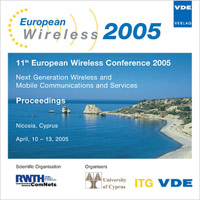Noncoherent Maximum Likelihood Synchronization of Multi-Antenna UWB-IR faded Systems
Conference: European Wireless 2005 - 11th European Wireless Conference 2005 - Next Generation wireless and Mobile Communications and Services
04/10/2006 - 04/13/2005 at Nicosia, Cyprus
Proceedings: European Wireless 2005
Pages: 7Language: englishTyp: PDF
Personal VDE Members are entitled to a 10% discount on this title
Authors:
Baccarelli, Enzo; Biagi, Mauro; Pelizzoni, Cristian; Cordeschi, Nicola (INFO-COM Dept., University of Rome ”La Sapienza”, via Eudossiana 18, 00184 Rome, Italy)
Garzia, Fabio (ICMMPM departement, MP division, via Eudossiana 18, 00184 Rome, Italy)
Abstract:
This contribution focuses on the (up to date unexplored) topic of the Maximum-Likelihood (ML) noncoherent synchronization of Multi-Antenna transceivers working in faded environments and employing Ultra Wide Band Impulse Radio (UWB-IR) transmit technology. In particular, the Cramer-Rao Bound (CRB) is presented for the general case of Multiple-Input-Multiple-Output (MIMO) UWB-IR systems and used to compare the ultimate performance of three basic transmit schemes, thereinafter referred to as Single-Input-Single-Output (SIMO), MIMO Equal Signaling (MIMO-ES) and MIMO Orthogonal Signaling (MIMO-OS) ones. Thus, the noncoherent ML synchronizer is developed for the most performing transmit scheme (e.g., the SIMO one) and its performance is evaluated under both signal-acquisition and tracking operating conditions. The performance gain in the synchronization of UWB-IR signals arising by the utilization of the Multi-Antenna technology is also evaluated.


